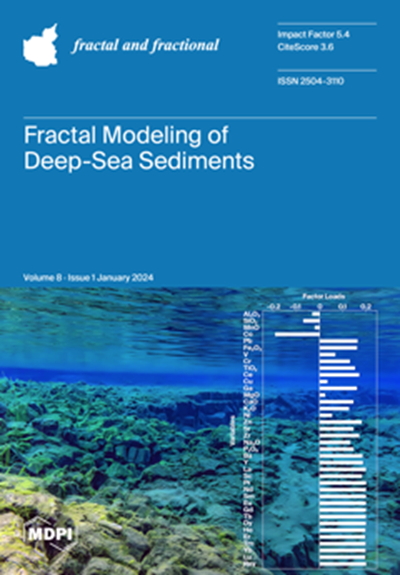干旱气候下天然纤维加固土壤因开裂而产生的分形特征
IF 3.6
2区 数学
Q1 MATHEMATICS, INTERDISCIPLINARY APPLICATIONS
引用次数: 0
摘要
分形几何学是一种以不规则几何形态为研究对象的几何学,可以定量描述粗糙不平的表面和界面。稻草纤维作为制作天然纤维土工布的主要材料,可以减少降雨对土壤的直接影响,降低水力侵蚀强度。本研究探讨了使用稻草纤维作为添加剂加固干旱土壤是否能抑制水分蒸发并防止开裂。将添加了不同纤维含量(0%、1%、2% 和 4%)的样品放置在环境室中,模拟干旱气候条件的影响,并控制温度和湿度水平。使用数码相机记录样品的开裂过程,并通过数字图像处理定量检测蒸发和开裂过程的参数。结果表明,所有含有纤维的样品都具有较高的残余含水量,与不含纤维的样品相比,残余含水量分别增加了 31.4%、58.5% 和 101.9%。此外,纤维含量较高的样品,即纤维含量为 2% 或 4% 的样品,其原生裂缝、次生裂缝以及裂缝网络均受到抑制。使用纤维增强的样品的裂缝率也更小。与不含秸秆纤维的样品相比,纤维含量为 1%、2% 和 4% 的样品的最终裂纹率分别降低了 8.05%、24.09% 和 35.01%。最后,纤维含量为 1%、2% 和 4% 的样品裂缝的最终分形尺寸也分别减少了 0.54%、5.50% 和 6.40%。添加天然纤维作为减少土壤蒸发性开裂的添加剂可以达到以下目的(1) 降低土壤孔隙度;(2) 增强土壤颗粒之间的结合力;(3) 堵塞疏水通道。因此,在土壤中添加稻草纤维可以有效减少土壤蒸发,抑制土壤开裂。本文章由计算机程序翻译,如有差异,请以英文原文为准。
Fractal Characteristics of Natural Fiber-Reinforced Soil in Arid Climate Due to Cracking
Fractal geometry is a geometry that focuses on irregular geometric forms and can quantitatively describe rough and uneven surfaces and interfaces. As the main material for making natural fiber geotextile, rice straw fiber can reduce the direct impact of rainfall on soil and reduce the intensity of hydraulic erosion. This study investigates whether the use of rice straw fiber as an additive to reinforce arid soil can inhibit moisture evaporation and prevent cracking. Samples with different fiber contents added (0%, 1%, 2%, and 4%) are placed in an environmental chamber to simulate the effects of an arid climatic condition and control the temperature and humidity levels. The cracking process of the samples is recorded by using a digital camera, and the parameters of the evaporation and cracking processes are quantitatively examined through digital image processing. The results show that all of the samples with fiber have a higher residual water content and can retain 31.4%, 58.5%, and 101.9% more water than without the fibers, respectively. Furthermore, both the primary and secondary cracks as well as crack networks are inhibited in samples with a higher fiber content, that is, 2% or 4% fiber contents. The samples reinforced with fiber also have a smaller crack ratio. Compared with the samples without straw fiber, the final crack ratio of the samples with 1%, 2%, and 4% fiber is reduced by 8.05%, 24.09%, and 35.01% respectively. Finally, the final fractal dimensions of the cracks in samples with fiber contents are also reduced by 0.54%, 5.50%, and 6.40% for the samples with 1%, 2%, and 4% fiber, respectively. The addition of natural fiber as an additive to reduce evaporative cracking in soil can: (1) reduce the soil porosity; (2) enhance the binding force between the soil particles; and (3) block the hydrophobic channels. Therefore, the addition of rice straw fiber to soil can effectively reduce soil evaporation and inhibit soil cracking.
求助全文
通过发布文献求助,成功后即可免费获取论文全文。
去求助
来源期刊

Fractal and Fractional
MATHEMATICS, INTERDISCIPLINARY APPLICATIONS-
CiteScore
4.60
自引率
18.50%
发文量
632
审稿时长
11 weeks
期刊介绍:
Fractal and Fractional is an international, scientific, peer-reviewed, open access journal that focuses on the study of fractals and fractional calculus, as well as their applications across various fields of science and engineering. It is published monthly online by MDPI and offers a cutting-edge platform for research papers, reviews, and short notes in this specialized area. The journal, identified by ISSN 2504-3110, encourages scientists to submit their experimental and theoretical findings in great detail, with no limits on the length of manuscripts to ensure reproducibility. A key objective is to facilitate the publication of detailed research, including experimental procedures and calculations. "Fractal and Fractional" also stands out for its unique offerings: it warmly welcomes manuscripts related to research proposals and innovative ideas, and allows for the deposition of electronic files containing detailed calculations and experimental protocols as supplementary material.
 求助内容:
求助内容: 应助结果提醒方式:
应助结果提醒方式:


